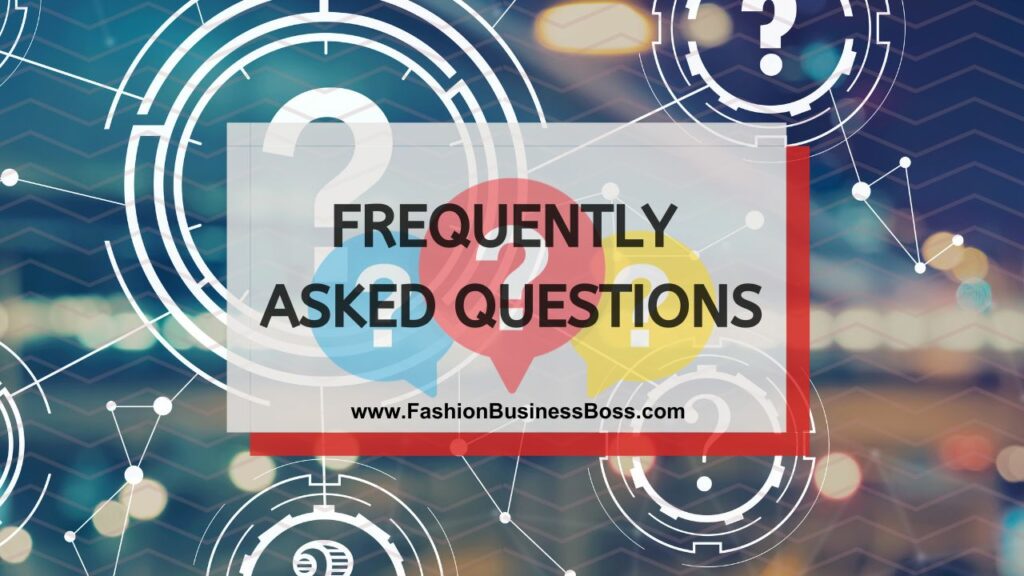Selling your clothing brand is an exciting venture that requires a combination of creativity, marketing savvy, and a deep understanding of your target audience.
To sell your clothing brand, start with a strong online presence through e-commerce websites and social media. Build a compelling brand story, create quality products, and market them effectively to your target audience. Collaborate with influencers and consider brick-and-mortar options for wider reach.
In this article, we will walk you through the steps to sell your clothing brand. From establishing your brand identity to leveraging digital marketing strategies, we will cover all the essentials to help you build a thriving clothing business.
Crafting Your Brand Identity

To get your clothing brand off the ground, it’s crucial to have a strong and captivating brand identity. What’s that, you ask? Well, it’s basically all about figuring out what your brand stands for, what it believes in, and what makes it stand out from the crowd.
First things first, you should pinpoint your brand’s mission. This is like your brand’s big purpose or reason for being. It could be about offering sustainable fashion, celebrating diversity, or making people feel confident in their clothes. Next up, think about your brand’s values. These are the principles and beliefs that guide your brand’s actions. Are you all about quality, affordability, or innovation? Your values will shape how you do business.
Now, let’s talk about those Unique Selling Propositions (USPs). These are the things that make your brand one-of-a-kind. Maybe it’s your eco-friendly materials, your handcrafted designs, or your unbeatable prices. USPs are what set you apart from the competition.
Why is all of this important? Well, your brand identity is like the blueprint for everything you do. It helps you create a consistent and memorable brand that customers can connect with. When you’ve got your brand identity nailed down, it’s easier to build a marketing strategy that resonates with your target audience.
Read more about: From Wardrobe to Runway: Your Journey into Clothes Modeling
Designing Quality Products
When it comes to making your clothing brand a hit, top-notch quality is the secret sauce. Your products are the heart and soul of your brand, so you want them to be the best they can be. That means putting in the time and hard work to create clothing that people will love.
Start by pouring your creative juices into designing your clothes. Think about what your target customers want, what makes them feel great, and what styles they’re into. Then, bring those ideas to life with high-quality materials and craftsmanship. It’s like cooking up a delicious meal with the finest ingredients.
Here’s the thing: happy customers are like your brand’s biggest cheerleaders. When they love what you offer, they’ll not only come back for more but also tell their friends and family about your brand. It’s like a ripple effect, and it all starts with quality.
Invest the time and effort needed to make your clothing top-notch. It’s an investment that pays off in the long run, as satisfied customers become loyal supporters who boost your brand’s reputation and help it grow. Quality is your brand’s best friend on the road to growth!
Building an Online Presence
In the world we live in today, being online is a must if you want your clothing brand to shine. Think of it like setting up a cool shop in the busiest part of town. First things first, you’ll want to create a website where people can check out your clothes and buy them with a few clicks. Make it super easy to navigate so customers feel right at home.
But that’s not all – social media is your buddy too! These platforms are like your storefront windows. Use them to show off your latest styles, connect with your fans, and let your brand’s personality shine through. It’s like having a conversation with your customers, but in the digital world.
Why is all of this so important? Well, people spend a lot of their time online, so that’s where you want to be to get noticed. When you have a great website and a lively social media presence, you’re making it easy for customers to find you and fall in love with your brand.
Effective Digital Marketing

Online advertising is like putting up big billboards on the internet highways. You can target your ads to the right people, so they see what you have to offer. Content marketing is like telling stories that people want to hear. Write blogs or make videos that connect with your customers and keep them interested.
Now, email campaigns, they’re like sending personal letters to your customers. It’s a great way to let them know about new arrivals, discounts, and all the cool stuff you’re up to. And social media? Well, that’s like throwing a big party and inviting everyone. You can chat with your customers, show off your styles, and have a blast doing it.
But here’s the thing: the digital world changes fast. So, you’ve got to keep up with the latest trends and make sure your marketing strategies match what your customers like. It’s like staying in tune with the latest fashion trends – you want to be on point.
Read more about: From Wardrobe to Wallet: Making and Selling Your Own Clothes
Collaborating with Influencers
Teaming up with influencers is like having cool friends who can introduce you to a whole new gang. It’s a smart move to make your clothing brand more visible. Here’s how it works.
First, you need to find influencers whose style matches your brand. Think of them as fashion buddies who share the same taste in clothes. When their followers see them rocking your outfits, it’s like a stamp of approval.
Now, when influencers genuinely love your clothing, their endorsements come across as authentic. It’s like a friend recommending a restaurant they can’t get enough of – people trust it. And when these influencers share your brand with their followers, it’s like an invitation to a cool party. You get to meet new people who might become your biggest fans.
The key is to build partnerships with influencers who vibe with your brand, and let them do what they do best – share their passion for your clothes. It’s a win-win: they get to wear awesome outfits, and you get to reach a broader audience. Influencers are like your fashion ambassadors, helping you tap into fresh customer bases and making your brand more visible than ever.
Exploring Brick-and-Mortar Options
In today’s digital world, it’s easy to get caught up in the online game, but don’t forget about the magic of physical stores. Imagine this: You’ve built a fantastic clothing brand that people love online, and now they want to touch, feel, and try on your clothes in person.
That’s where brick-and-mortar stores or pop-up shops come in. They’re like the real-world versions of your online store. When people walk into a physical store, it’s like stepping into your brand’s world. They can see the colors, feel the fabrics, and get a sense of the quality – it’s a sensory experience that can’t be replicated online.
But here’s the real kicker: physical stores build trust and recognition. When customers can walk into a store and interact with your brand, it feels more real and reliable to them. It’s like meeting a friend face-to-face; you connect on a deeper level.
Leveraging E-Commerce Platforms

Think of these e-commerce platforms like giant malls where millions of shoppers hang out every day. Your website is your personal store, but why not also have a few more branches in these bustling malls? Let’s break it down.
We’ve all heard of Amazon, eBay, and Etsy, right? They’re like the biggest shopping destinations on the internet, with loads of people browsing for stuff they love. So, when you set up shop on these platforms, you’re putting your clothing brand right in front of a massive crowd.
Here’s the sweet part: these platforms already have hordes of shoppers looking for cool stuff. When they stumble upon your brand while shopping for other goodies, it’s like making new friends who might fall in love with your clothes. Plus, they make buying super easy and secure, which shoppers love.
Read more about: Funds and Fashion: Startup Costs for Your Clothing Store
Analyzing Data and Adapting
Picture data analytics as your trusty detective, helping you unravel the mysteries of your customers’ behavior and supercharge your strategies. It’s like having a magnifying glass to examine every detail. Here’s the scoop.
You’ve got these awesome tools like Google Analytics and social media insights. Think of them as your Sherlock Holmes and Watson. They collect loads of data about what’s happening on your website and social media pages. This data reveals all sorts of things – what products are popular, where people are coming from, and what they do on your site.
Now, why is this so important? Well, it’s like having a treasure map. You can spot trends, see what’s working, and what needs a tweak. It’s not guesswork; it’s using facts to make decisions. For instance, if you see that a particular style of clothing is flying off the shelves, you can focus on that and give your customers more of what they want.
Building a Strong Customer Community
Creating a sense of belonging for your customers is like hosting a warm and welcoming gathering at your place. It’s all about making them feel like part of a big, happy family. Let’s dive into how you can do that.
Start by using social media as your virtual hangout spot. It’s like throwing a friendly get-together online. Share stories, ask questions, and encourage your customers to join the conversation. When they see that you’re not just a brand but also a friend who listens, it builds a strong bond.
Now, feedback is golden! When customers talk, it’s like sharing their thoughts at the dinner table. Listen carefully and respond genuinely. Whether it’s praise, suggestions, or concerns, let them know you’re there, and their opinions matter.
Loyalty programs are like throwing a surprise party for your most loyal pals. Consider setting up programs that reward customers who keep coming back for more. It could be discounts, exclusive previews, or special treats – something to make them feel appreciated.
Handling Challenges and Staying Resilient

Selling a clothing brand, or any business, is like a rollercoaster ride with ups and downs. Challenges are part of the journey, but they’re also the stepping stones to progress. Let’s talk about how to tackle them.
First, setbacks happen to the best of us. Maybe a new collection didn’t perform as expected, or you faced supply chain issues. It’s like when a thunderstorm ruins your picnic plans. But here’s the thing: setbacks are your chance to learn and grow. They teach you what works and what doesn’t. So, when the next storm rolls in, you’ll be better prepared with an umbrella.
Market conditions can change in the blink of an eye, just like fashion trends. What’s hot today might be old news tomorrow. Stay flexible, like a tree swaying in the wind. Keep an eye on what’s happening in the industry, adapt your strategies, and be ready to pivot when needed. It’s all about staying relevant and riding the waves.
Competition is like a friendly game of basketball – it keeps you on your toes. Instead of fearing it, embrace it. Study your competitors, understand what they do well, and find your unique edge. It’s like discovering your signature style in the fashion world.
Every obstacle you face is an opportunity for growth. Think of it as leveling up in a video game. Each challenge you overcome makes you stronger and wiser. Don’t shy away from challenges; embrace them as a chance to improve and innovate.
Read more about: Garments for Trade: Designing Your Clothes for Sale
Summary
Selling your clothing brand is a journey that requires dedication, creativity, and a deep understanding of your audience. By crafting a strong brand identity, producing quality products, and effectively leveraging digital marketing strategies, you can create a thriving clothing business.
Stay adaptable, keep your customers at the forefront, and embrace the challenges as opportunities to grow your brand and make a lasting impact in the fashion industry.
Frequently Asked Questions

1. How can I establish a strong brand identity for my clothing brand?
Creating a compelling brand story, defining your mission and values, and identifying unique selling propositions are key steps in crafting a robust brand identity that resonates with your target audience.
2. What digital marketing strategies work best for selling clothing brands?
Effective digital marketing strategies for clothing brands include social media marketing, content marketing, email campaigns, and online advertising. Tailor your approach to match your brand’s style and your customers’ preferences.
3. Is it necessary to have a physical retail presence for my clothing brand?
While not mandatory, physical retail, such as brick-and-mortar stores or pop-up shops, can enhance brand trust and recognition. Consider it as a complementary channel to reach a broader customer base.
To learn more about starting your own clothing business, check out my startup documents here.
The information provided by FashionBusinessBoss.com (“The Site”) is for general informational purposes only. All information on the Site is provided in good faith, however, we make no representation or warranty of any kind, express or implied, regarding the accuracy, adequacy, validity, reliability, availability or completeness of any information on the Site. Under no circumstance shall we have any liability to you for any loss or damage of any kind incurred as a result of the use of the Site or Reliance on any information provided on the Site. Your use of the Site and your reliance on any information on the Site is solely at your own risk. This blog post is for educational purposes only and does not constitute legal advice. Please consult a legal expert to address your specific needs. Terms and Conditions. (https://fashionbusinessboss.com/terms-and-conditions/)

Meet Shawn Chun: Entrepreneur and Fashion Business Fan.
I’m a happy individual who happens to be an entrepreneur. I have owned several types of businesses in my life from a coffee shop to an import and export business to an online review business plus a few more and now I create online resources for those interested in starting new ventures. It’s demanding work but I love it. I do it for those passionate about their business and their goals. That’s why when I meet a designer or boutique owner at a craft fair, farmers market, retail location or anywhere else I see myself. I know how hard the struggle is to retain clients, find good employees and keep the business growing all while trying to stay competitive.
That’s why I created Fashion Business Boss: I want to help fashion business owners like you build a thriving business that brings you endless joy and supports your ideal lifestyle.

